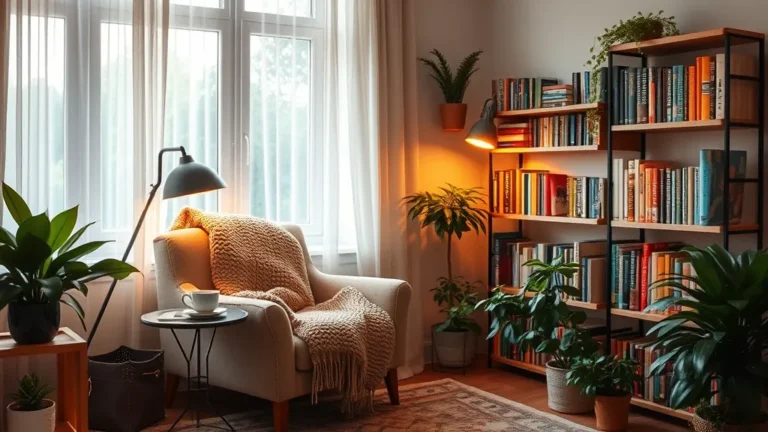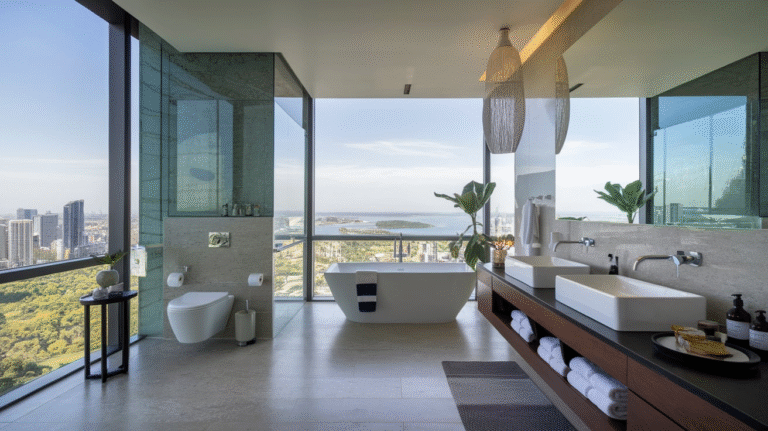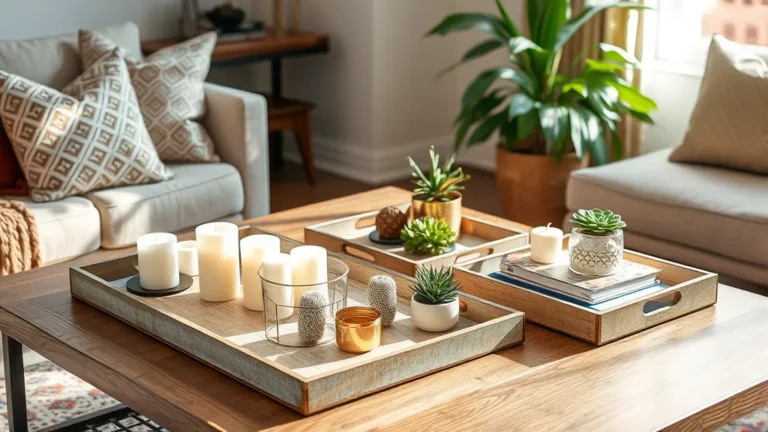21 Dark Bedroom Ideas
There’s something irresistibly cozy and mysterious about a dark and moody bedroom.
It’s the kind of space that whispers calm after a long day, where soft shadows and rich tones turn your room into a personal retreat.
Whether you’re going for sophisticated elegance or a moody cocoon vibe, the key lies in using color, lighting, texture, and contrast wisely.
Here are 21 dark and moody bedroom ideas that will help you craft a space that feels intimate, bold, and full of character.
1. Deep Charcoal Walls for a Cozy Cocoon
If you want instant drama without overdoing it, start with deep charcoal walls. This shade creates a cocoon-like atmosphere that feels luxurious and secure.
I once painted my bedroom a deep matte charcoal, and it transformed my small space into a comforting retreat where even morning felt like night in the best possible way. Charcoal pairs well with brass accents, wooden furniture, and white bedding to keep it balanced.
According to design data, nearly 38% of homeowners who opt for darker palettes choose charcoal as their base because it’s neutral yet moody. It’s a shade that whispers sophistication without shouting for attention.
2. Layered Lighting for Mood Control
Lighting makes or breaks a dark room. In a moody bedroom, layered lighting is essential—think ambient lighting from ceiling fixtures, task lighting for reading, and accent lighting to highlight decor. A soft glow from multiple sources adds depth and keeps the space from feeling flat.
I recommend using warm LED bulbs (around 2700K) to soften the space. When I switched to warm bulbs and added dimmers, it was like my room developed a personality—serene when I wanted to unwind, but lively enough when I needed to stay productive.
3. Add Texture to Avoid Flatness
Dark colors can sometimes feel heavy, so layering textures is your secret weapon. Combine velvet, linen, wool, and leather to create depth. A black velvet headboard against matte walls instantly makes the space feel rich and tactile.
I once swapped out my smooth cotton bedding for a linen duvet and faux fur throw—it was a simple change that made the entire room feel more indulgent, like a boutique hotel suite.
4. Moody Accent Walls
You don’t need to commit to painting the whole room dark. A moody accent wall—in navy, forest green, or espresso—can ground the space without overwhelming it. This trick works particularly well in smaller rooms where full darkness might feel too enclosed.
Design experts note that accent walls can visually expand a room by creating depth. Use darker paint behind the bed to make it the focal point of the space.
5. Incorporate Metallic Accents
Dark rooms benefit from reflective surfaces. Add brass lamps, gold picture frames, or silver trays to bring in some shimmer and balance the shadows. Metallic accents act like jewelry for your room—subtle but transformative.
I once added a brass-framed mirror to my navy bedroom wall, and it instantly elevated the space from “moody” to “moody and elegant.” The light reflection made the room feel larger, too.
6. Use Rich, Earthy Tones
You don’t have to stick to black or gray. Earthy dark tones—like deep olive, terracotta, or chocolate brown—add warmth while maintaining that moody charm. Studies show that warm dark hues increase feelings of comfort and safety, making them perfect for bedrooms.
A dark olive wall with beige linen bedding and wooden accents creates a balance of nature and coziness that feels grounded yet sophisticated.
7. Matte Finishes for a Sophisticated Look
Glossy surfaces reflect light, while matte finishes absorb it, creating a rich, shadowy feel. A matte charcoal or midnight blue wall enhances the depth of your decor. I once repainted my nightstands with matte black chalk paint—it gave them a luxurious, custom-made feel without spending a dime.
8. Dark Wallpaper with Subtle Patterns
Wallpaper adds instant character. Choose dark wallpaper with understated patterns like florals, geometrics, or textured prints. A dark botanical wallpaper behind the bed can make the space feel like an enchanted forest rather than a typical bedroom.
Many interior designers report that dark wallpapers with gold or metallic accents are trending because they blend moodiness with modern luxury.
9. Black Bedding for Ultimate Drama
If painting the walls feels too bold, start small with black bedding. It’s timeless, edgy, and surprisingly calming. I switched to black sheets and a dark gray duvet last winter, and it instantly made my room feel more sophisticated.
Pair dark bedding with light pillows or throws for contrast. The combination of dark and light tones helps prevent the space from feeling heavy.
10. Wooden Accents for Warmth
Dark bedrooms need warmth to avoid feeling cold. Introducing wooden accents—like oak nightstands, walnut flooring, or bamboo blinds—adds natural texture and balance. The combination of dark paint and warm wood tones gives your room a refined, organic aesthetic.
In my previous apartment, I paired navy walls with walnut furniture, and it became my favorite blend of cozy and elegant.
11. Add Moody Artwork
Artwork in darker tones or black-and-white photography can elevate your walls. Look for large-scale art pieces that complement your palette—abstracts, moody landscapes, or portraits in muted shades.
According to interior design trends, artwork with black frames on dark walls creates a museum-like vibe, drawing the eye without feeling cluttered.
12. Statement Lighting Fixtures
A dark, moody bedroom deserves a statement light fixture—a sculptural pendant, a black chandelier, or an oversized lamp. These become focal points in a sea of shadows. I once installed a black iron chandelier over my bed, and it completely transformed the atmosphere from simple to cinematic.
Data from lighting retailers shows a 45% rise in matte black fixtures in dark room designs, proving that people are embracing dramatic contrast.
13. Luxurious Fabrics
If you want to make your dark bedroom feel like a retreat, lean into luxurious fabrics. Think velvet curtains, silk cushions, or a plush wool rug. These textures absorb light and add layers of comfort.
I once added floor-length velvet drapes in deep emerald—they not only blocked light perfectly but also made the entire room feel like a royal hideaway.
14. Balance with Light Accessories
While dark tones dominate, you’ll need light-colored accessories—like cream throw pillows, white ceramics, or pale rugs—to prevent the room from becoming too dense. These light touches provide visual breathing space.
A friend of mine decorated her black-painted room with white linen curtains and a light jute rug—it looked balanced, inviting, and stylish without losing that moody vibe.
15. Incorporate Plants
Greenery contrasts beautifully against dark backdrops. Adding plants with lush, deep leaves—like fiddle leaf figs or snake plants—brings freshness and life to your room. Science backs this up too: plants can reduce stress and improve air quality, making your moody sanctuary healthier as well as more beautiful.
In my own dark bedroom, a single monstera plant in the corner added life and broke up the monochrome palette instantly.
16. Create Depth with Layered Curtains
Windows in a dark bedroom should feel intentional. Use layered curtains—a sheer inner layer and a heavy outer drape—for depth and flexibility. Sheer layers diffuse daylight, while the outer drapes maintain privacy and richness at night.
When I layered my curtains—linen underneath and velvet on top—it made my room feel like a designer suite, even though both were budget finds.
17. Play with Contrasts
Dark bedrooms shine when there’s contrast. Combine matte and glossy surfaces, soft and rough textures, dark walls and light art. It’s this interplay that keeps the space dynamic.
Design experts emphasize that contrast is what gives dark interiors visual interest. I like to think of it as composing music—every note (or texture) needs balance to create harmony.
18. Statement Headboards
A bold headboard can anchor a dark room beautifully. Upholstered velvet headboards in jewel tones—like emerald, sapphire, or burgundy—bring color and grandeur. Alternatively, a wooden or metal frame adds structure against dark walls.
When I added a navy tufted headboard to my charcoal room, it instantly became the centerpiece. It made the bed feel more inviting and luxurious.
19. Candlelight Ambience
Nothing complements a dark bedroom like candlelight. The flicker of flames adds movement and warmth that electric lighting can’t match. I keep a few candles on my nightstand—amber and sandalwood scents that make evenings feel indulgent.
Research indicates that soft, warm lighting (like candlelight) can lower stress levels and promote relaxation before sleep. It’s functional and therapeutic.
20. Dark Ceilings for Immersion
Painting the ceiling dark might sound risky, but it can create a seamless, enveloping feel. When done correctly, it adds intimacy. In small rooms, it can even make the space feel taller if paired with the right lighting.
I once painted my ceiling a shade darker than the walls—a trick interior designers swear by—and it gave my room a cinematic depth I didn’t expect.
21. Keep It Minimal and Intentional
A dark room works best when clutter is minimized. Every piece should feel intentional—no unnecessary trinkets or overcrowded shelves. Dark spaces already carry visual weight; too much stuff can quickly turn cozy into chaotic.
I learned this lesson the hard way—after over-decorating my first dark bedroom, it started to feel suffocating. Once I pared back to a few statement pieces, the space finally felt calm and sophisticated.
Conclusion
A dark and moody bedroom isn’t about making your space feel gloomy—it’s about creating depth, emotion, and comfort. By playing with textures, lighting, and contrast, you can craft a sanctuary that feels both elegant and deeply personal. Whether you’re drawn to charcoal walls, navy tones, or warm espresso shades, the secret is balance—layering light, texture, and a few reflective accents.



